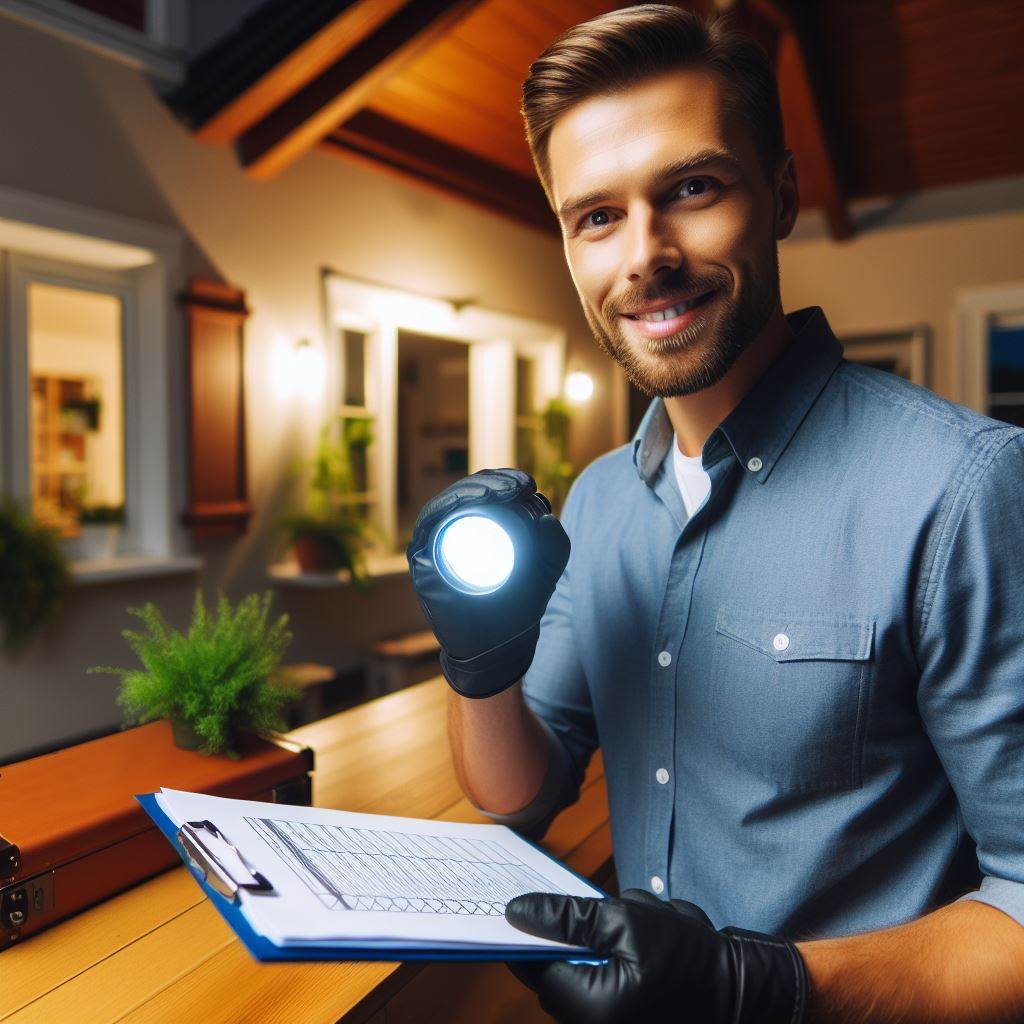Introduction
A home inspection is a comprehensive examination of a property’s condition, typically conducted by a certified inspector.
It involves assessing various components of the house, including its structure, plumbing, electrical systems, heating, and cooling systems, among others.
The primary goal is to identify any existing or potential issues that could affect the safety, functionality, or value of the property.
A home inspection is a crucial step in the home buying or selling process.
For buyers, it provides valuable insight into the condition of the property they are interested in purchasing.
It helps them make informed decisions and avoid unexpected expenses down the line.
For sellers, a pre-listing inspection can uncover any issues that may arise during negotiations, allowing them to address these issues beforehand and potentially increase the value of their home.
The purpose of this blog post is to highlight key areas that should be checked during a home inspection.
By understanding what to look for and what questions to ask, both buyers and sellers can better navigate the inspection process and ensure that no critical issues are overlooked.
From structural integrity to safety hazards and everything in between, we will explore the essential components of a thorough home inspection.
In the subsequent sections, we will delve into specific areas that inspectors typically assess during a home inspection.
From the foundation to the roof, we will discuss common issues to watch out for and provide tips on how to address them.
By the end of this post, readers will have a better understanding of what to expect during a home inspection and how to interpret the findings.
Stay tuned as we uncover the secrets to a successful home inspection, helping you make confident decisions whether you’re buying or selling a property.
Exterior Inspection
Performing a thorough home inspection is crucial before making one of the most significant purchases in our lives.
An inspection helps identify potential problems, assess the condition of the property, and determine if there are any immediate or future repair needs.
This blog section will focus on the key areas to check during an exterior inspection.
By thoroughly inspecting these key areas, you can gain valuable insights into the overall condition of the house.
It is advisable to hire a professional home inspector who possesses the expertise and knowledge required to identify potential issues accurately.
Roof and gutters
During the roof and gutter inspection, the inspector will carefully examine the roofing materials, such as shingles or tiles.
They will identify any damages, such as cracks, curling, or missing pieces, which could lead to water leaks or further structural deterioration.
Adequate drainage is essential to prevent water accumulation, as it can cause water damage and lead to foundation issues.
Siding and foundation
The siding and foundation examination focuses on identifying any signs of wear, cracks, or bulges.
These could indicate structural issues or poor drainage, which can lead to costly repairs in the future.
It is also important to address any water damage promptly, as it can compromise the integrity of the entire structure.
Windows and doors
Windows and doors are subject to wear and tear over time.
The functionality of windows and doors is crucial for ventilation, natural light, and security.
The inspector will test each window and door, ensuring they open, close, and lock properly.
Damaged frames, cracked glass, or faulty hardware should be noted for repair or replacement.
Checking for air leaks and damaged seals can prevent energy loss and improve the overall insulation efficiency of the home.
In fact, the exterior inspection plays a vital role in assessing the condition of a home.
It is crucial to check the roof and gutters, siding and foundation, as well as windows and doors.
By thoroughly examining these areas, potential issues can be identified, allowing for informed decisions and necessary repairs.
A professional home inspection provides peace of mind and ensures a safe and secure living environment.
Read: Credit Score Insights for Potential Homeowners
Interior Inspection
In a comprehensive home inspection, it is crucial to thoroughly assess the interior of the property.
This allows potential homeowners to identify any existing or potential issues that may affect their comfort or safety.
The interior inspection includes key areas such as the plumbing system, electrical system, and HVAC system.
Plumbing system
The first aspect of the plumbing system that should be inspected is the pipes, drains, and water heaters.
The inspector should look for any signs of leaks or corrosion, which can lead to significant water damage if left untreated.
Additionally, the water pressure and functionality of fixtures, such as sinks, toilets, and showers, should be evaluated to ensure they are in good working condition.
Electrical system
The electrical system is another essential component to check during a home inspection.
The inspector should carefully examine the electrical panels and wiring for any hazards or potential issues, such as outdated or faulty wiring.
Testing outlets, switches, and light fixtures is also crucial to ensure they are functioning properly and meeting safety standards.
HVAC system
Homeowners rely heavily on their heating, ventilation, and air conditioning (HVAC) systems to maintain a comfortable indoor environment.
During an interior inspection, the inspector should inspect the HVAC units, including furnaces, air conditioners, and ventilation systems, to check for proper functioning.
Any signs of malfunction or inefficiency should be noted. It is also important to assess the condition of filters and ducts, as clogged or dirty filters can affect the system’s performance and indoor air quality.
Proper inspection of these key areas is essential in understanding the overall condition of a property’s interior.
Any issues identified can then be addressed by homeowners or included in negotiations with the seller.
It is recommended to hire a qualified and experienced home inspector to ensure a thorough and accurate assessment.
In short, the interior inspection of a home covers critical aspects such as the plumbing system, electrical system, and HVAC system.
The pipes, drains, and water heaters should be checked for leaks or corrosion, while the water pressure and functionality of fixtures must be evaluated.
Electrical panels, wiring, outlets, switches, and light fixtures should also be examined to identify potential hazards.
Finally, the HVAC units, filters, and ducts need to be inspected to ensure proper functioning and indoor air quality.
Taking the time to address these areas during a home inspection can save homeowners from costly repairs and provide them with peace of mind.
Read: Low Credit? Home Buying Strategies for You

Structural Inspection
When conducting a home inspection, one of the key areas that require thorough examination is the structural integrity of the property.
A sound structure ensures the safety and longevity of your investment.
It is crucial to pay close attention to the attic and insulation, basement and crawl spaces, and the overall structural condition.
Attic and Insulation
- Checking for proper insulation levels and ventilation is essential to maintain energy efficiency within the home. Inadequate insulation can lead to high energy bills and discomfort.
- Assessing the condition of the roof structure is crucial for identifying any signs of damage, such as sagging or missing roof supports, which can compromise the integrity of the entire property.
Basement and Crawl Spaces
- Inspecting for signs of water damage, leaks, or structural issues helps identify potential problems like mold growth, foundation cracks, or compromised structural elements.
- Evaluating the integrity of the foundation and support beams ensures the safety and stability of the property. Cracked or damaged foundations can lead to costly repairs if left unattended.
Overall Structural Integrity
- Assessing the general condition of walls, floors, and ceilings is necessary to identify any visible signs of damage or deterioration. Structural issues can manifest as cracks or uneven surfaces.
- Looking for signs of cracks, settlement, or other structural problems beyond the specific areas mentioned above is crucial. These can include issues such as bowing walls, sloping floors, or misaligned windows and doors that may indicate a larger structural concern.
During a home inspection, it is essential to hire a qualified professional who can meticulously assess the property’s structural integrity.
They will provide a comprehensive report detailing any concerns or areas that require immediate attention.
Remember, addressing structural issues promptly can prevent further damage and costly repairs in the future.
In essence, when conducting a home inspection, be sure to prioritize the examination of the structural integrity.
Focus on key areas such as the attic and insulation, basement and crawl spaces, and the overall condition of walls, floors, and ceilings.
By doing so, you can ensure the safety, durability, and value of your investment.
Read: Loan Approval Tips: Strengthen Your Application
Additional Areas of Inspection
A home inspection goes beyond the basic checks and looks into other crucial areas to ensure a safe and sound living environment.
In this section, we will discuss two key areas that should be examined during a thorough home inspection.
Termites and Pests
Termites and pests can wreak havoc on a property, causing structural damage and compromising the safety of its occupants.
Therefore, a comprehensive home inspection should include a careful examination for signs of infestation or damage caused by these unwanted critters.
Home inspectors will look for evidence such as termite tubes, wood damage, or droppings that may indicate an active infestation.
Furthermore, they will assess the need for pest control treatments to address the problem effectively.
It is essential to eliminate pests and prevent further damage, as the structural integrity of the home could be compromised.
Additionally, pests can also pose health risks to the residents, making it crucial to identify and eradicate any infestations.
Environmental Hazards
Environmental hazards can have severe consequences on both the health and safety of the inhabitants.
Therefore, a comprehensive home inspection should also include an assessment of potential environmental hazards that may exist within the property.
This includes testing for radon gas, which is a naturally occurring radioactive gas that can accumulate in enclosed spaces and cause lung cancer.
Inspectors may also check for the presence of mold, as exposure to certain types of mold can lead to respiratory problems and allergies.
Moreover, the inspection may include identifying the presence of asbestos, a hazardous material commonly used in older homes.
Asbestos fibers, when disturbed, can become airborne and lead to serious respiratory issues and even cancer.
By conducting thorough inspections, home inspectors can identify any potential risks and recommend necessary remediation measures.
This might involve the need for professional abatement for asbestos or mold, or implementing ventilation systems to mitigate radon gas levels.
Ensuring these environmental hazards are addressed will help create a safe and healthy living environment for the occupants.
All in all, a comprehensive home inspection extends beyond the standard checks and includes additional areas of concern.
By examining termites and pests as well as assessing environmental hazards, such as radon, mold, and asbestos, inspectors can help homeowners identify potential issues and take appropriate remedial actions.
Prioritizing comprehensive inspections ensures a safe and habitable home for the future occupants.
Read: Improve Credit Fast: Home Buying Edition
Conclusion
When it comes to purchasing a new property, hiring a professional home inspector is of utmost importance.
They have the expertise and knowledge to thoroughly inspect a home, ensuring that buyers have a clear understanding of the condition of the property they are interested in.
Throughout this blog post, we have discussed various key areas that should be checked during a home inspection.
These include the foundation, roof, electrical system, plumbing, HVAC system, and the overall structural integrity of the property.
Before making the biggest investment of their lives, potential homeowners must prioritize a thorough home inspection.
This will help them identify any potential issues or defects, allowing them to make an informed decision and avoid future costly repairs or surprises.
A professional home inspector will provide an in-depth analysis of the property, highlighting any safety hazards or concerns.
Ultimately, having a comprehensive understanding of the condition of the property will give buyers peace of mind and the confidence to proceed with the purchase.
Remember, a home inspection is not a task to be overlooked or underestimated.
It is an essential step in the home-buying process that can save buyers from potential headaches and financial burdens in the future.
So, before sealing the deal on your dream home, don’t forget to consult a professional home inspector and prioritize a thorough inspection.
It’s a small investment that can go a long way in ensuring your future happiness and satisfaction with your new property.




